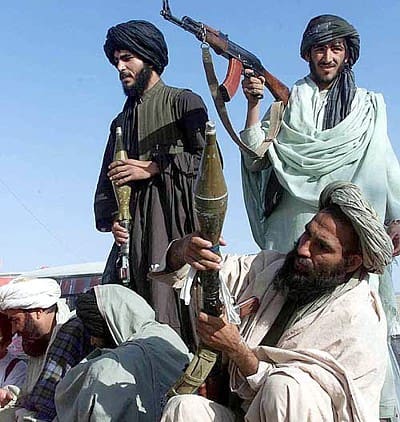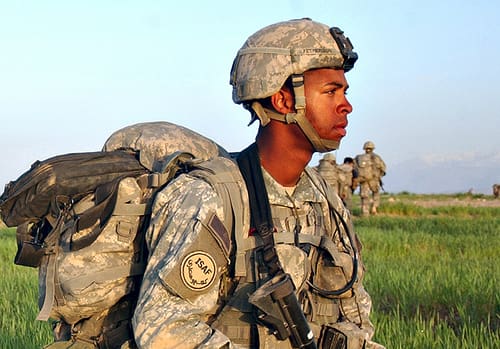TTAG writer Brad Kozak and I were shooting the breeze (Brad 1, Breeze 0) when we got to talking about the war in Afghanistan. “It looks like we won the war and lost the peace,” Brad opined. Roger that. I’m generally in favor of wars of liberation. I know America can’t free the entire world from tyranny. But in those cases where we can, and do, I’m not going to spend too much time worrying about whether we should have. But I despair at our strategic sloth, inter-service rivalry and failure to adapt our military presence to local conditions. When the Taliban were large and in charge, we won. Now? Not so much. Or, more accurately, too much. For example, the technology and camo-laden American troops in-country look about as much like the civilians whose hearts and mind they’re supposed to win as an F-22 looks like Wright Flyer I. Are U.S. forces even “in country?” They sully forth from bases that are about as indigenous as, well, you get the point. Example B: the ongoing (and going and going) “debate” over our troops’ guns and ammo.
As Military.com reports, an Army major’s graduate paper “Increasing Small Arms Lethality in Afghanistan: Taking Back the Infantry Half Kilometer” is causing major heartburn within the force. Our so-called military leaders are gradually beginning to consider the idea that maybe, just maybe, the front line troops in Afghanistan have the wrong tools for the job.
Thomas Ehrhart, an infantry officer attending the elite Army School for Advanced Military Studies at Fort Leavenworth, wrote that the Army undertrained and underequipped its front-line units to battle insurgent forces over long ranges in mountainous terrain.
Debate over the study comes amid a series of major reviews within the service over improvements to the M4 rifle, a possible replacement for the Soldier’s basic carbine, and radical changes to the equipment used by troops in Afghanistan, including a new camouflage combat uniform that better matches that country’s varied terrain.
The study contains some withering criticisms. Ehrhart takes the Army to task for failing to implement the “designated marksman” concept, giving the strategy short shrift in both training and practice. He excoriates the Army for sitting on its proverbial hands re: increasing the caliber of its bullets from its current 5.56mm round to somewhere between 6.5 – 7mm—“the general conclusion of all military ballistics studies since the end of World War I.”
Ehrhart’s study was released in November ’09. The problem of improper weapons and bullets has been simmering since the ar began (October 7, 2001). Nearly ten years. What’s being done now? We’ll get to that as the Pentagon does: eventually (or, as my wife says,”later soon”). First, read ’em and weep.
Ehrhart wrote that despite the fact that 50 percent of Army engagements in Afghanistan occur with the enemy attacking at 300 meters or beyond, the majority of Soldiers are trained to fire their M4 carbines accurately to 200 meters, and more than 80 percent of Joes in an infantry company are equipped with weapons that can’t touch the enemy beyond that range.
The enemy in Afghanistan, Ehrhart writes, “engages United States forces from high ground with medium and heavy weapons, often including mortars, knowing that we are restricted by our equipment limitations and the inability of our overburdened soldiers to maneuver at elevations exceeding 6000 feet.”
The weapon systems that can engage the enemy in Afghanistan effectively beyond 200 meters “represent 19 percent of the company’s firepower,” he adds. “This is unacceptable.”
The idea that the U.S. Army is outgunned in 50 percent of its engagements is almost as stunning as the United States Air Force’s decision not to equip the Vietnam War-era Phantom F4 with, wait for it, guns. If you think about it, and someone should, the strategy here is not a million miles away from the one deployed in Southeast Asia. More is better. A lot more is a lot better. Aircraft guns? We don’t need no stinkin’ aircraft guns! We have missiles! Designated snipers? We’ve got helicopter gunships!
Simple? Simple doesn’t come in to it.
In Afghanistan, this “big bad wolf” philosophy applies to air strikes, Predator drones, troop stregnth, field equipment, bases, bribes to local leaders, everything. And when the armed forces adopts that basic mindset, even when it “gets” that it needs to change, it fails to assimilate the larger lesson: small is beautiful. The end result isn’t very attractive. Read this excerpt to the end.
Tamilio noted that the Army is in the midst of equipping each infantry squad with two EBR-14 systems — modified M14 7.62mm rifles — so more Soldiers will have the range and stopping power to engage the enemy with direct fire. Officials are also scouring the weapons lockers of special operations units to see if some of their firepower could be fielded to general purpose units to boost their capabilities.
But officials are reluctant to equip units with too many weapons that meet long-range needs at the expense of the close-range capability. Tamilio said the 5.56mm M4 worked well in the close-range urban fights of Iraq, but Afghanistan is proving the need for more options with heavier rounds.
Fuller added that his team has offered three Army brigades deploying to Afghanistan as part of the “surge” additional firepower for their operations, including the special operations M4A1 that can fire in full-auto mode and new long-range scopes.
“I can’t give it to the whole Army,” he explained. “But I can field an increased capability so you can have a little more kit in your kit bag to adapt to that environment.”
MORE kit? Have you SEEN what an American soldier in Afghanistan looks like? Here’s a pic of a U.S. soldier out on a mission. [NB: He doesn’t have dark, eye-obscuring sunglasses on, the default option for our troops.] Did I mention that he’s wearing the “new” medium field pack (3,000 cubic inch-capacity), introduced in December of last year. No wait, it’s a prototype, hurried to the troops after the brass figured out that the big ass packs were “contributing to Soldier fatigue and injuries.”
See that? Not “inappropriate for combat conditions” or offensive to local style (yes style) or stuffed with a whole lot of gear the soldier doesn’t need (if, God forbid, their tactics are wrong) or could live without (increasing mobility). It’s an OSHA-type deal.
Compare and contrast with the image that started this piece. Now check this out from allgov.com: “Another problem is that enemy forces in Afghanistan have learned to attack from high ground because they know that U.S. soldiers can’t operate effectively at elevations higher than 6,000 feet.” I wonder why THAT is.
I’m not suggesting that American soldiers should “go native”—oh wait, I am. If it works for the special forces, and so I’ve heard, why not the resrt of our fighting force?
While I sincerely hope that the Afghans view Americans as liberators and peace-keepers—for that is what we are—we look like a god damn virus. And that’s before the whoop whoop whoop of machine gun-enabled V-22 title rotor indicates that a squad of adrenalin charged Marines is about to descend from on high.
Back to the guns, then. We’re already reported on the Marine’s partial and belated switch to more deadly and effective SOST rounds. So what’s else is being done about the M4-toting troops getting their ass kicked by the Taliban’s mortars and AK-47s?
Ehrhart’s critique has attracted the notice of senior commanders who are considering changes for the Afghan campaign. These include improvements designing bullets that can remain lethal past 500 meters, redesigning the M4 rifle, completely replacing the carbine altogether, and developing new camouflage uniforms that better match the terrain.
Considering? Again, it’s been a year since Ehrhart took his employer to task for their insufficient weaponry. Yes I know: politics. Politics within the Army, between the forces, against the Pentagon; for, with and against elected officials. In America, politics is all.
You could say that the war against terror in Afghanistan is, ultimately, a war between competing ideologies. Ours is best. BUT, while U.S. forces occupy the moral high ground, we’re not doing so well on the actual ground. We should fix that, and then fix the system that created the problem in the first place.
Write your reps. Email this article around. Demand that our government do it takes to assure the safety of our troops and win the peace in Afghanistan: create a smaller, more mobile, more “Afghan friendly” force with weaponry appropriate to the task.
And vote for candidates who favor a smaller government, in the hopes that we can remove the layers of military bureaucracy that created this sad state of affairs in the first place, subjecting our brave, steadfast soldiers to unnecessary, deadly risk. In this as in so many other thing, a smaller government is a better, more effective government. Just ask the Taliban.






Sorry to say that there are many errors with this writing. The U.S. Forces are not out gunned at all. The Ak47 is not effective at all past 200 meters. The sights and horrible ballistics of the 7.62×39 round limit the AK to short range. Marines are trained to hit man targets out to 500-600 with the M-16s.shot with a scope out to 400 meters are easy with an AR-15 or M4-M16. With a change in round the M16 family of weapons could be even better but as it stands now the M4 is far better then an inaccurate AK.
From what I hear on TTV and the Internet. There is a problem with the short barrel M4 not having enough barrel to achive the feet per second to be a efective round.
The enemy is using old british 303 enfields left from WW2. The old rifles can beat our .223 rounds at long distance any day, with their iron sights.
Any good deer rifle/ bolt action in calibur ,308 7.62 nato we use in our M60 machine gun will defeat the brit .303.
War history has plenty of guns in the desert.
Rommel got chased buy the 303 also.
We need a gun for close work and a semi for long distance.
In the past our 45 acp and carbine worked fine close up.
The springfield 3006 and the M1 garand 3006 worked well at over 500 yards and up to 1,000.
The ammo was heavy/ Our Marines are in great shape.
A lot of misinformation in this article. An AK47 may be powerful and reliable, however, it’s horribly inaccurate, inefficient and carries a limited amount of ammunition compared to the M4-M16 carbine/rifle. The grunts in Nam could carry around 1,5oo rounds of 5.56mm. I would be extremely impressed by a man who could carry 1,500 rounds of AK47 ammunition on him. Does the US military need a new rifle? Maybe, maybe not. It’s possible to change calibers and barrel lengths with the M16/M4 weapons. Take out the old 5.56mm upper receiver and replace it with a 6.5mm Grendel upper & try that one on for size. If I was the boss at Colt I would definitely be playing that angle with the US military. They would already have “conversion kits” for field testing. Instead the military is going to the FN SCAR MK17 which costs around three times as much as an M4 and isn’t as good as the Gene Stoner M16/M4 designed weapon in my opinion, the SCAR’s reciprocating charging handle and fore-end heat build-up are but two things that make me think this. My view is that it is not so much the rifle that needs to changed but the caliber and barrel length that needs to be changed. If only way-back-when the powers-that-be would have chambered the AR15 in a caliber comparable to the .243 Winchester this debate would not have existed.
…and six years later, nothing’s changed.
Comments are closed.